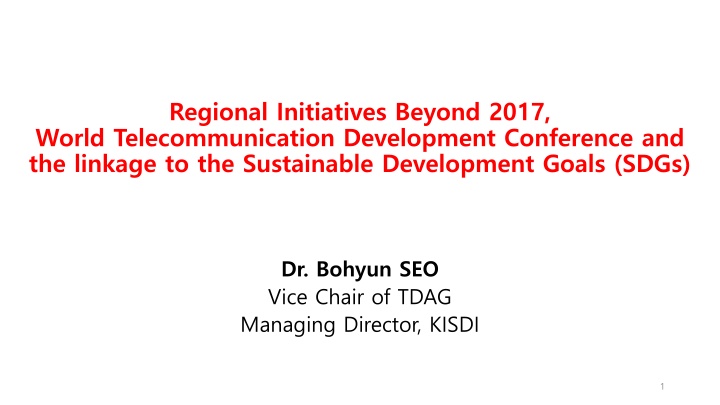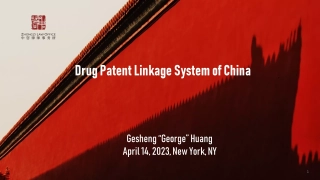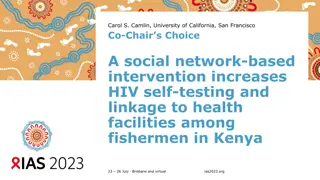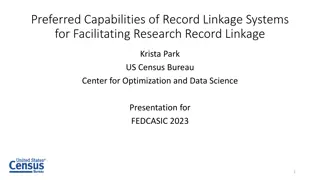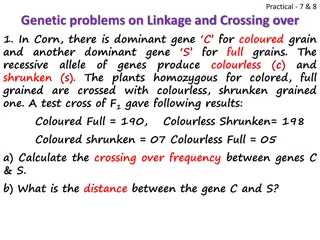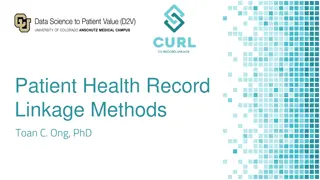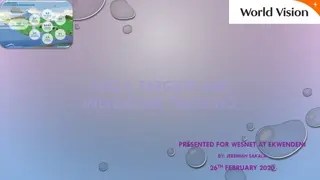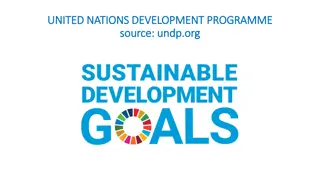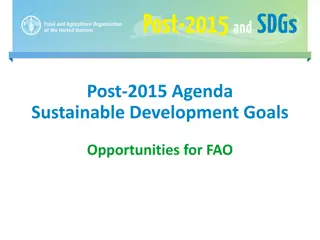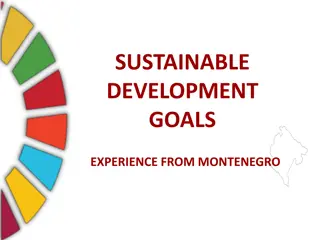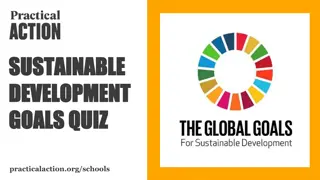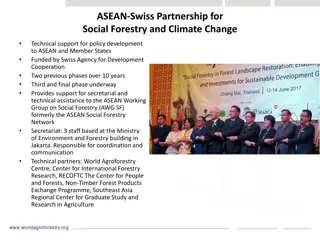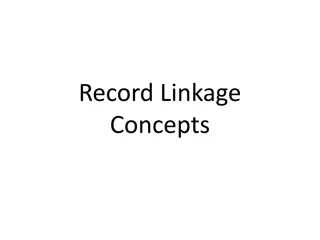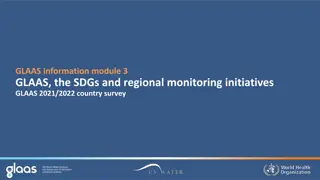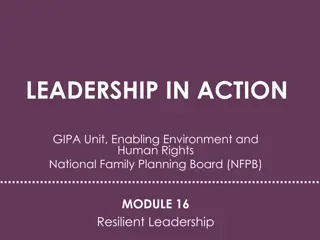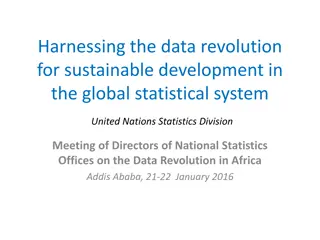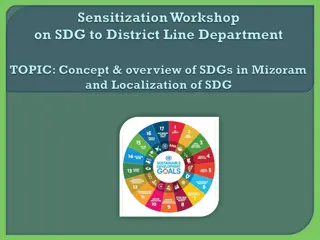Regional Initiatives Beyond 2017: Linkage to Sustainable Development Goals
The article discusses the connection between the World Telecommunication Development Conference in 2017 and the Sustainable Development Goals (SDGs). It explores the transition from Millennium Development Goals (MDGs) to SDGs and the impact of ICT, WSIS ALs, and RIs on achieving the SDGs. The SDGs aim to address global challenges such as poverty, gender equality, education, health, climate change, and more by 2030.
Download Presentation

Please find below an Image/Link to download the presentation.
The content on the website is provided AS IS for your information and personal use only. It may not be sold, licensed, or shared on other websites without obtaining consent from the author.If you encounter any issues during the download, it is possible that the publisher has removed the file from their server.
You are allowed to download the files provided on this website for personal or commercial use, subject to the condition that they are used lawfully. All files are the property of their respective owners.
The content on the website is provided AS IS for your information and personal use only. It may not be sold, licensed, or shared on other websites without obtaining consent from the author.
E N D
Presentation Transcript
Regional Initiatives Beyond 2017, World Telecommunication Development Conference and the linkage to the Sustainable Development Goals (SDGs) Dr. Bohyun SEO Vice Chair of TDAG Managing Director, KISDI 1
Table of Contents 1. MDGs and SDGs 2. SDGs and ICT 3. WSIS ALs for SDGs 4. RIs for SDGs 2
1. MDGs & SDGs/MDGs - The Millennium Development Goals (MDGs) were the eight international development goals for the year 2015 that had been established following the Millennium Summit of the United Nations in 2000, following the adoption of the United Nations Millennium Declaration. All 189 United Nations member states at the time (there are 193 currently), and at least 23 international organizations, committed to help achieve the following Millennium Development Goals by 2015: 1) To eradicate extreme poverty and hunger 2) To achieve universal primary education 3) To promote gender equality and empower women 4) To reduce child mortality 5) To improve maternal health 6) To combat HIV/AIDS, malaria, and other diseases 7) To ensure environmental sustainability 8) To develop a global partnership for development 3
1. MDGs & SDGs/SDGs - At the United Nations Sustainable Development Summit on 25/09/15, world leaders adopted the 2030 Agenda for Sustainable Development, which includes a set of 17 Sustainable Development Goals (SDGs) to end poverty, fight inequality and injustice, and tackle climate change by 2030. Sustainable Development Goals(SDGs) Sustainable Development Goals(SDGs) Goal 1 Goal 2 End poverty in all its forms everywhere End hunger, achieve food security and improved nutrition and promote sustainable agriculture Ensure healthy lives and promote well-being for all at all ages Goal 10 Goal 11 Reduce inequality within and among countries Make cities and human settlements inclusive, safe, resilient and sustainable Ensure sustainable consumption and production patterns Goal 3 Goal 12 Goal 4 Ensure inclusive and equitable quality education and promote lifelong learning opportunities for all Achieve gender equality and empower all women and girls Goal 13 Take urgent action to combat climate change and its impacts Goal 5 Goal 14 Conserve and sustainably use the oceans, seas and marine resources for sustainable development Protect, restore and promote sustainable use of terrestrial ecosystems, sustainably manage forests, combat desertification, and halt and reverse land degradation and halt biodiversity loss Promote peaceful and inclusive societies for sustainable development, provide access to justice for all and build effective, accountable and inclusive institutions at all levels Strengthen the means of implementation and revitalize the global partnership for sustainable development Goal 6 Ensure availability and sustainable management of water and sanitation for all (6.a, 6.b) Goal 15 Goal 7 Ensure access to affordable, reliable, sustainable and modern energy for all Goal 16 Goal 8 Promote sustained, inclusive and sustainable economic growth, full andproductiveemploymentanddecentworkforall Build resilient infrastructure, promote inclusive and sustainable industrialization and foster innovation Goal 17 Goal 9 4
1. MDGs & SDGs/Comparison MDG SDG Traditional assistance Traditional assistance + Universal goals More comprehensive Inclusive goal setting Traditional + Data revolution Distinction Quality Education Broader set of financial sources Limited goals Top-down process Traditional statistics Hunger and poverty together Quantity Education Funding: Focus on ODA 7
2. SDGs and ICT/ SDGs targets related to ICTs - While none of the SDGs is specifically about ICTs, several targets make references to ICTs and technology 1.4) By 2030, ensure that all men and women, in particular the poor and the vulnerable, have equal rights to economic resources, as well as access to basic services, ownership and control over land and other forms of property, inheritance, natural resources, appropriate new technology and financial services, including microfinance 4.3) By 2030, ensure equal access for all women and men to affordable and quality technical, vocational and tertiary education, including university 4.4) By 2030, substantially increase the number of youth and adults who have relevant skills, including technical and vocational skills, for employment, decent jobs and entrepreneurship 4.b) By 2020, substantially expand globally the number of scholarships available to developing countries, in particular least developed countries, small island developing States and African countries, for enrolment in higher education, including vocational training and information and communications technology, technical, engineering and scientific programmes, in developed countries and other developing countries 5.b) Enhance the use of enabling technology, in particular information and communications technology, to promote the empowerment of women 9.1) Develop quality, reliable, sustainable and resilient infrastructure, including regional and transborder infrastructure, to support economic development and human well-being, with a focus on affordable and equitable access for all 8
2. SDGs and ICT/ SDGs targets related to ICTs 9.5) Enhance scientific research, upgrade the technological capabilities of industrial sectors in all countries, in particular developing countries, including, by 2030, encouraging innovation and substantially increasing the number of research and development workers per 1 million people and public and private research and development spending 9.c) Significantly increase access to information and communications technology and strive to provide universal and affordable access to the Internet in least developed countries by 2020 16.10) Ensure public access to information and protect fundamental freedoms, in accordance with national legislation and international agreements 17.6) Enhance North-South, South-South and triangular regional and international cooperation on and access to science, technology and innovation and enhance knowledge sharing on mutually agreed terms, including through improved coordination among existing mechanisms, in particular at the United Nations level, and through a global technology facilitation mechanism 17.7) Promote the development, transfer, dissemination and diffusion of environmentally sound technologies to developing countries on favourable terms, including on concessional and preferential terms, as mutually agreed 17.8) Fully operationalize the technology bank and science, technology and innovation capacity-building mechanism for least developed countries by 2017 and enhance the use of enabling technology, in particular information and communications technology 17.16) Enhance the global partnership for sustainable development, complemented by multi-stakeholder partnerships that mobilize and share knowledge, expertise, technology and financial resources, to support the achievement of the sustainable development goals in all countries, in particular developing countries 17.17) Encourage and promote effective public, public-private and civil society partnerships, building on the experience and resourcing strategies of partnerships 9
2. SDGs and ICT/ SDG indicators related to ICTs - ITU has made a concerted effort to highlight the role that ICTs will play in achieving the SDGs. It is actively participating in the discussions on the indicators that will be used to track the SDGs - The February 2016 version of the IAEG-SDGs(Inter-agency and Expert Group on SDGs) report includes the following 7 ICT indicators covering 6 targets under Goals 4, 5, 9, and 17. (The organization indicated in brackets tracks the indicator at the international level). <Proposed SDG indicators related to ICTs> Target 4a: Proportion of schools with access to the Internet for pedagogical purposes (UIS) Target 4a: Proportion of schools with access to computers for pedagogical purposes (UIS) Target 4.4: Proportion of youth/adults with ICT skills, by type of skills (ITU) Target 5b: Proportion of individuals who own a mobile telephone, by sex (ITU) Target 9c: Percentage of the population covered by a mobile network, broken down by technology (ITU) Target 17.6: Fixed Internet broadband subscriptions, broken down by speed (ITU) Target 17.8: Proportion of individuals using the Internet (ITU) 10
3. WSIS ALs for SDGs WSIS Action Lines Facilitator Facilitator ECOSOC/UN Regional Commissions/ITU ITU 1. The role of public governance authorities and all stakeholders in the promotion of ICTs for development 2. Information and communication infrastructure C3. Access to information and knowledge C4. Capacity building C5. Building confidence and security in the use of ICTs C6. Enabling environment C7. ICT Applications E-government E-business E-learning E-health E-employment E-environment E-agriculture E-science ITU ITU ITU ITU/UNESCO UNDP/UNESCO/ITU ITU/UNCTAD ITU ITU ITU ITU/UNDP/UN Regional Commissions/ UNCTAD UNDP/ITU ITU ITU/ /UPU /ITU/UNIDO WHO/ITU ITU ILO/ITU ITU WTO/UNCTAD/ITU UNESCO/ITU/ WHO/WMO/UNEP/UN-Habitat ITU ITU/ICAO FAO/ITU UNESCO/ITU ITU/UNCTAD UNESCO UNESCO UNESCO/ECOSOC UN Regional Commissions/UNDP/ITU ITU C8. Cultural diversity and identity, linguistic diversity and local content C9. Media C10. Ethical dimensions of the Information Society C11. International and regional cooperation /ITU/UNESCO/ECOSOC 11
3. WSIS ALs for SDGs: Matrix C1 C2 C3 C4 C5 C6 C8 C9 C10 C11 e-gov e-bus e-lea e-hea e-emp e-env e-agr e-sci SDG 1 SDG 2 SDG 3 SDG 4 SDG 5 SDG 6 SDG 7 SDG 8 SDG 9 SDG 10 SDG 11 SDG 12 SDG 13 SDG 14 SDG 15 SDG 16 12 SDG 17
4. RIs for SDGs Regional Initiatives - Intended to address specific telecommunication/ICT priority areas, through partnership and resource mobilization Africa /Americas/ Arab States / Asia-Pacific / CIS /Europe < Asia-Pacific Regional Initiatives> 2010 2010- -2014 2014 2015-2018 1. Special consideration for least developed countries, small island developing states, including Pacific island countries, and landlocked developing countries 2. Emergency telecommunications 3. Harnessing the benefits of new technologies 4. Development of broadband broadband 5. Policy and regulation 1. Unique ICT needs of least developed countries(LDCs), small island developing States(SIDS) and landlocked developing countries(LLDCs) 2. Emergency telecommunications 3. Digital broadcasting 4. Broadband access and uptake in urban and rural areas 5. Telecommunication/ICT policy and regulation in ASP region ? access and adoption of 13
4. RIs for SDGs 2015 2015- -2018 ASP 2018 ASP- -RI RI SDG (Goal) SDG (Goal) SDG (Target) SDG (Target) Goal 3, Goal 4, Goal 7, Goal 9, Goal10, Goal 13, Goal17 Goal 11, Goal 13 Goal 1, Goal 5, Goal 9 3.c, 4.b, 4.c, 7.b, 9.a, 10.b, 13.b, 17.5, 17.18 11.5, 11b, 13.1, 13.3 1.4, 5.b. 9.5 1 1. . Special Special Consideration Consideration for for LDCs, LDCs, SIIDS, SIIDS, LLDCs LLDCs 2 2. . Emergency Emergency telecommunications telecommunications 3 3. . Harnessing Harnessing the the benefits 4 4. . Development Development of of Broadband of of broadband broadband benefits of of new Broadband access new technologies technologies access and and adoption adoption Goal 9 9.1, 9.c 1.b, 16.b, 17.6, 17.3, 17.14. 17.15, 17.16, 17.17 5 5. . Policy Policy and and regulation regulation Goal 1, Goal 16, Goal 17 SDG SDG1 1 SDG2 SDG2 SDG3 SDG3 SDG4 SDG4 SDG5 SDG5 SDG6 SDG6 SDG7 SDG7 SDG8 SDG8 SDG9 SDG9 SDG10 SDG10 SDG11 SDG11 SDG12 SDG12 SDG13 SDG13 SDG SDG14 14 SDG15 SDG15 SDG16 SDG16 SDG17 SDG17 RI 1 RI 1 RI 2 RI 2 RI 3 RI 3 RI 4 RI 4 RI 5 RI 5 14
4. RIs for SDGs RIs-ASP beyond 2017 15
